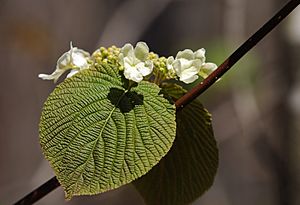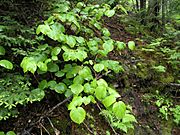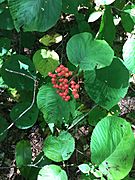Viburnum lantanoides facts for kids
Quick facts for kids Viburnum lantanoides |
|
|---|---|
 |
|
| Scientific classification | |
| Genus: |
Viburnum
|
| Species: |
lantanoides
|
| Synonyms | |
|
V. alnifolium Marshall |
|
The Hobble-Bush (its scientific name is Viburnum lantanoides) is a cool plant that grows in the woods. People also call it witch-hobble or moosewood. It's a type of plant that lives for many years and grows like a bush, usually 2 to 4 meters (about 6 to 12 feet) tall.
One special thing about the hobble-bush is its branches. They hang down and can even touch the ground. When they touch, they can grow new roots! This makes it easy for people walking through the woods to trip over them – which is how it got the name "hobble-bush." It's like the branches are trying to "hobble" or trip you!
In May or June, this bush gets pretty clusters of white or pink flowers. The flowers on the outside of the cluster are bigger, about 3 to 5 centimeters wide. The whole cluster can be about 10 centimeters across. Its leaves are large and heart-shaped, with锯齿状 edges, usually 10 to 20 centimeters long. The bark is gray-brown and bumpy. Later, it grows red fruits that look like small berries. These fruits turn black when they are ready to eat.
The flowers are important for nature! They give sweet nectar to butterflies, like the beautiful Spring Azure butterfly. Many animals, such as mammals and birds, enjoy eating its fruits, twigs, and leaves. Interestingly, the big, showy flowers on the edge of the cluster don't make seeds. Only the smaller flowers in the middle have both male and female parts to create new seeds.
Where Does Hobble-Bush Grow?
The hobble-bush is found in the eastern parts of the United States and Canada. You can see it from Georgia all the way up to the Maritimes in Canada. It likes to grow in places where the ground is rich, wet, and a bit acidic. You might spot it near streams, in swamps, or in moist forests.
How People Use Hobble-Bush
The fruits of the hobble-bush can be eaten! You can eat them raw, or people sometimes use them to make tasty jelly.
Gallery




